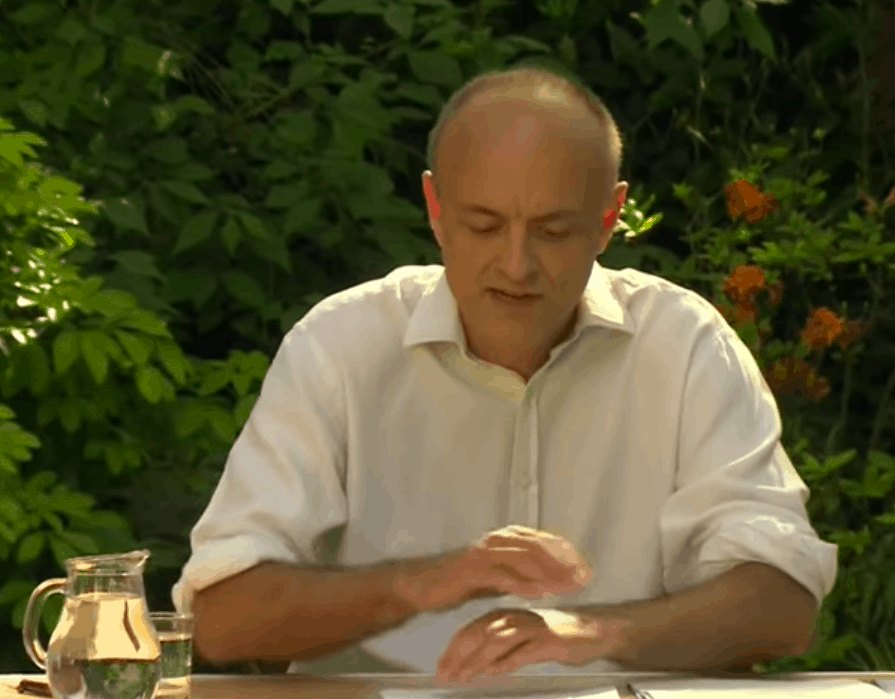
One rule for the establishment, another for everyone else…
Owen Jones, The Guardian
If you live in the UK it will have been hard to avoid the media coverage about Dominic Cummings’ trip to Durham just after the start of the Coronavirus lockdown.
What incensed many Brits further was his televised statement given on 25 May from the Rose Garden at 10 Downing St. Many were expecting an apology for flouting the strict lockdown rules, but instead heard a series of lukewarm excuses.

Dominic Cummings reading his statement in the Rose Garden at Number 10
Then Allen Green at the Financial Times did a fascinating analysis of how the wording of the statement has been put together by a lawyer, giving at least three reasons for every action in case any assertion is later refuted.
Fast Data Science - London
That got me wondering: did Cummings write his statement or his lawyers?
I have tried to find this out using forensic stylometry, the science of identifying authors by their writing styles.
I had some code lying on my computer from an earlier experiment where I investigated whether JK Rowling really did write The Cuckoo’s Calling. I collected posts from Cummings’ blog and a few other famous people in the political or public sphere and I calculated the similarity between the writing styles. (Incidentally, if you manage to read one of the lengthy posts on his blog from start to finish I will be impressed.)
When I calculated the probability of Cummings being the author, the results were inconclusive. My model gave a probability of about 50% that he wrote his statement. He was a more likely author than any of my other candidates.
 model output. Probability of likely authors of the Rose Garden statement](https://fastdatascience.com/images/graph-1.png)
Probability of likely authors of the Rose Garden statement, based on personalities’ blog posts and writings and calculated using the Burrows’ delta algorithm.
I think that the reality is somewhere in the middle. Cummings probably drafted the statement and his lawyers made it legally watertight. The stylometry analysis is indicating he most likely made at least some contribution. This would make it a collaborative effort.
If you have a set of documents and you’d like to determine authorship, or simply extract data from them, I’d be keen to hear from you. Just write a comment or send me a message.
Unfortunately the Burrows’ delta method of stylometry, which I used, tends to perform best on longer texts like books. There has been research into stylometry techniques that use deep learning and word vectors (Jasper et al), and which are capable of identifying authorship of short documents, however this is much harder to do that Burrows’ delta.
Unleash the potential of your NLP projects with the right talent. Post your job with us and attract candidates who are as passionate about natural language processing.
Hire NLP Experts
Thomas Wood presents the Clinical Trial Risk Tool before the November meeting of the Clinical AI Interest Group at Alan Turing Institute The Clinical AI Interest group is a community of health professionals from a broad range of backgrounds with an interest in Clinical AI, organised by the Alan Turing Institute.

Fast Data Science will appear at Ireland’s Expert Witness Conference on 20 May 2026 in Dublin On 20 May 2026, La Touche Training is running the Expert Witness Conference 2026, at the Radisson Blu Hotel, Golden Lane, Dublin 8, Ireland. This is a full-day event combining practical workshops and interactive sessions, aimed at expert witnesses and legal professionals who want to enhance their expertise. The agenda covers critical topics like recent developments in case law, guidance on report writing, and techniques for handling cross-examination.

Guest post by Alex Nikic In the past few years, Generative AI technology has advanced rapidly, and businesses are increasingly adopting it for a variety of tasks. While GenAI excels at tasks such as document summarisation, question answering, and content generation, it lacks the ability to provide reliable forecasts for future events. GenAI models are not designed for forecasting, and along with the tendancy to hallucinate information, the output of these models should not be trusted when planning key business decisions. For more details, a previous article on our blog explores in-depth the trade-offs of GenAI vs Traditional Machine Learning approaches.
What we can do for you